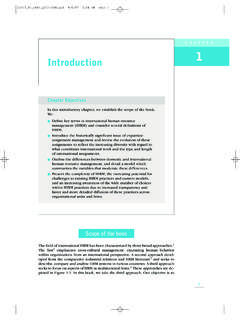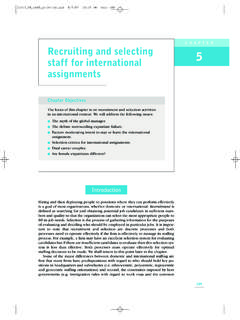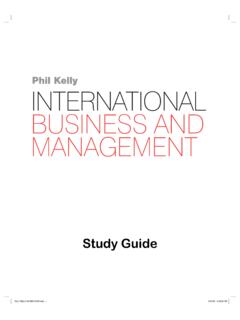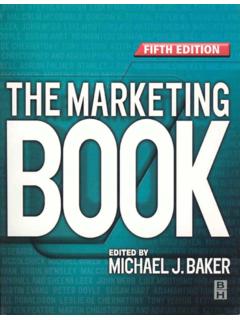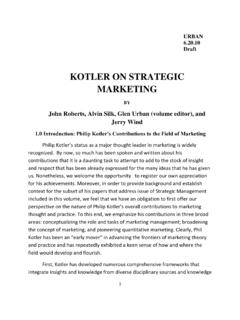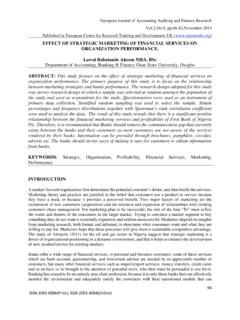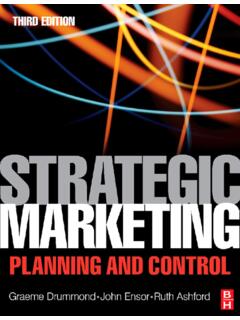Transcription of MARKETING: a brief introduction - Cengage EMEA
1 1 marketing : a brief introduction DAVID STOKES WENDY LOMAX Student s Supplement 2 introduction Approach The book is structured around an active learning approach. Although a considerable amount of information is presented in the text, the aim is to impart skills and knowledge by engaging the reader in interesting activities and exercises which build on existing experiences and understanding. marketing is ideally suited to this approach because we experience and witness it consciously or unknowingly most days of our lives. The primary focus of marketing is on customers and their needs, and we are all customers with needs. Therefore we can draw on our own experiences as consumers in a wide range of contexts to develop and check our understanding of marketing theory and see how it is applied in practice.
2 We can use our experiences as a shopper to develop a better understanding of retail marketing . We can reflect on our own use of education and health services to understand better the marketing of services in the public sector. We are all exposed to advertising and packaging messages and can think of those that influence us and those that have less impact. If we have access to the Internet, we can make our own judgments on the implications of this latest development on marketing . marketing activities are going on around us all the time from market surveys in the high street to mail shots received at home, and they all offer an opportunity to learn about marketing . How to use this book This book can be used as a work book with the facilitation of a teacher or ecturer in the classroom, or as the basis of unsupervised work at home, or a lmixture of both.
3 Owever used, the cases, activities and exercises are the basis for the learning roceHp ss. It is recommended that the book is used in the following way: First read the short case at the beginning of each chapter. These describe a particular scenario and ask the reader to draw conclusions about marketing principles from it. Attempt the activities at the end of each case. If necessary use the indicator to sections in the text to complete the activities, but first try to develop answers independently of the text. If you can discover marketing principles for yourself by observing them in practice you are more likely to fully understand and appreciate the theory. Read through the text and the examples.
4 Reflect on your understanding of the text through the Checkpoint exercises which attempt to relate theory to personal practice 3 Read the final case study and undertake the activities at the end of each chapter. These are designed to develop and confirm your understanding of theory by personal experimentation and practice. Although it may be tempting to move on to the next chapter, it is important to attempt the ongoing exercise of Developing a marketing plan at the end of each chapter so that skills can be built incrementally. Action Learning n summary, to get the most out of this book follow an action learning cycle of: ractice RefIP lection Theory Experimentation Practise marketing as an outside observer for example by considering first the case at the beginning of each chapter which describes an aspect of marketing in action.
5 Reflect on what this reveals about marketing through the activities at the end of th e case Theorise about the principles of marketing as described in the main text and the example s given of marketing in practice. Experiment through your own personal experiences in the checkpoints and exercise s in each chapter. Practise what you have learned through the ongoing exercise of developing a marketing plan. his s T upplement reviews each chapter by: Providing a summary of the contents of each chapter. Asking self test questions on specific sections of the text. swers to Suggesting typical examination questions and providing outline anthe key examination questions at the end of the section.
6 A comprehensive list of web links and further reading references. 4C hapter 1 What is marketing ? Summary Traditional marketing starts with the orientation of the enterprise around customer needs. In order to ensure this, formalised gathering of market intelligence underpins all aspects. A process of segmentation, targeting and positioning is used to develop a marketing strategy that meets customer needs. This strategy is implemented through the elements of the marketing mix. As a management philosophy, the marketing concept represents a strategy invo lving three basic propositions: Customer orientation the primary focus of the organisation is on the needs of the customer Organisational integration everyone in the organisation accepts and implements a customer orientation.
7 It is not just the responsibility of the marketing department Mutually beneficial exchange there has to be a balance between the needs of the customer and the strengths of an organisation so that it too can get its needs met. lte A rnative orientations which can be adopted include: Production orientation focussing on the efficiency of supply Product orientation stressing the highest possible product specification and quality Service orientation emphasising the expertise of the service deliverer Sales orientation using sales techniques to sell what is available Although the basic principles of marketing are as old as trade itself, it has developed rapidly as a body of knowledge since the 1950's, with successive industry types and economic sectors adopting a more customer oriented approach.
8 The Internet has created new opportunities for marketing and enabled organisations to become more accessible to individual customers. The most rapid development of Internet applications was in business to business, rather than business to consumer, markets. Tradsons: itional marketing principles have been challenged for several rea The seeming lack of effectiveness of marketing strategies in some market conditions or circumstances Entrepreneurs abilities to successfully develop new businesses based on individual intuition rather than formalised assessment of market needs 5 The potentially detrimental effects on society. This has lead to the notion of 'societal marketing that puts the welfare of society into the balance alongside customer and organisational needs.
9 Self test questions 1. How would you define marketing ? Why do you think the marketing concept is sometimes misunderstood or defined too narrowly? See section 2. What three basic ideas are fundamental to the marketing concept? How would you describe each one? See section 3. Organisations can adopt alternative orientations to the marketing concept. Can you name and describe three of these? See section 4. marketing has been practiced since trade began but it has only been formalised into a taught discipline in relatively recent times. What were some of the factors that made this necessary? Can you trace the adoption of more formal marketing practices in the economy since the 1950s?
10 See section 5. It has been suggested that in some circumstances the marketing concept is an inappropriate management approach. Describe some of these circumstances. Do you agree that marketing has less to offer in these cases? See section 6. The adoption of the marketing concept by many sectors of our economy has been linked to a variety of undesirable social effects. What are these undesirable social effects and do you agree that they can be directly linked to marketing ? See and Examination questions A. Define the marketing concept . Discuss its relationship to other business orientations (suggested answer follows in Outline answers to some examination questions ).. Several factors make it imperative for organisations to be marketing Boriented.

